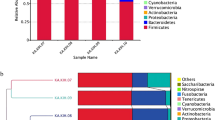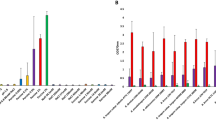Abstract
Bifidobacterium bifidum is part of the core microbiota of healthy infant guts where it may form biofilms on epithelial cells, mucosa, and food particles in the gut lumen. Little is known about transcriptional changes in B. bifidum engaged in synergistic multispecies biofilms with ecologically relevant species of the human gut. Recently, we reported prevalence of synergism in mixed-species biofilms formed by the human gut microbiota. This study represents a comparative gene expression analysis of B. bifidum when grown in a single-species biofilm and in two multispecies biofilm consortia with Bifidobacterium longum subsp. infantis, Bacteroides ovatus, and Parabacteroides distasonis in order to identify genes involved in this adaptive process in mixed biofilms and the influence on its metabolic and functional traits. Changes up to 58% and 43% in its genome were found when it grew in three- and four-species biofilm consortia, respectively. Upregulation of genes of B. bifidum involved in carbohydrate metabolism (particularly the galE gene), quorum sensing (luxS and pfs), and amino acid metabolism (especially branched chain amino acids) in both multispecies biofilms, compared to single-species biofilms, suggest that they may be contributing factors for the observed synergistic biofilm production when B. bifidum coexists with other species in a biofilm.





Similar content being viewed by others
Data Availability
Raw sequencing reads generated from this study are deposited at the NCBI sequence read archive (SRA) in a Bioproject (PRJNA736549) under accession numbers SRR14839360 (R1), SRR14839359 (R2), and SRR14839348 (R3) for three replicates of single-species biofilms of Bifidobacterium bifidum, SRR14839349 (R1), SRR14839350 (R2), and SRR14839347 (R3) for all replicates of three species biofilms (ABC), and SRR14839346 (R1), SRR14839345 (R2), and SRR14839344 (R3) for all replicates of the four-species biofilm (ABCD).
References
Sadiq FA et al (2021) Community-wide changes reflecting bacterial interspecific interactions in multispecies biofilms. Crit Rev Microbiol 47:338–358. https://doi.org/10.1080/1040841x.2021.1887079
Flemming H-C et al (2016) Biofilms: an emergent form of bacterial life. Nat Rev Microbiol 14:563–575. https://doi.org/10.1038/nrmicro.2016.94
Joshi RV, Gunawan C, Mann R (2021) We are one: multispecies metabolism of a biofilm consortium and their treatment strategies. Front Microbiol 12. https://doi.org/10.3389/fmicb.2021.635432
Flemming H-C, Wuertz S (2019) Bacteria and archaea on Earth and their abundance in biofilms. Nat Rev Microbiol 17:247–260. https://doi.org/10.1038/s41579-019-0158-9
Raghupathi PK et al (2017) Synergistic interactions within a multispecies biofilm enhance individual species protection against grazing by a pelagic protozoan. Front Microbiol 8:2649. https://doi.org/10.3389/fmicb.2017.02649
Lee KWK et al (2014) Biofilm development and enhanced stress resistance of a model, mixed-species community biofilm. ISME J 8:894–907. https://doi.org/10.1038/ismej.2013.194
Crabbé A, Jensen PØ, Bjarnsholt T, Coenye T (2019) Antimicrobial tolerance and metabolic adaptations in microbial biofilms. Trends Microbiol 27:850–863. https://doi.org/10.1016/j.tim.2019.05.003
Ren D, Madsen JS, Sørensen SJ, Burmølle M (2015) High prevalence of biofilm synergy among bacterial soil isolates in cocultures indicates bacterial interspecific cooperation. ISME J 9:81–89. https://doi.org/10.1038/ismej.2014.96
Røder HL et al (2015) Interspecies interactions result in enhanced biofilm formation by co-cultures of bacteria isolated from a food processing environment. Food Microbiol 51:18–24. https://doi.org/10.1016/j.fm.2015.04.008
Lapointe C, Deschênes L, Ells TC, Bisaillon Y, Savard T (2019) Interactions between spoilage bacteria in tri-species biofilms developed under simulated meat processing conditions. Food Microbiol 82:515–522. https://doi.org/10.1016/j.fm.2019.03.022
Zupančič J et al (2018) Synergistic interactions in microbial biofilms facilitate the establishment of opportunistic pathogenic fungi in household dishwashers. Front Microbiol 9:21. https://doi.org/10.3389/fmicb.2018.00021
Brandwein M, Steinberg D, Meshner S (2016) Microbial biofilms and the human skin microbiome. NPJ Biofilms Microbiomes 2:3. https://doi.org/10.1038/s41522-016-0004-z
Kolenbrander PE, Palmer RJ, Periasamy S, Jakubovics NS (2010) Oral multispecies biofilm development and the key role of cell–cell distance. Nat Rev Microbiol 8:471–480. https://doi.org/10.1038/nrmicro2381
Motta J-P, Wallace JL, Buret AG, Deraison C, Vergnolle N (2021) Gastrointestinal biofilms in health and disease. Nat Rev Gastroenterol Hepatol 18:314–334. https://doi.org/10.1038/s41575-020-00397-y
Venturelli OS et al (2018) Deciphering microbial interactions in synthetic human gut microbiome communities. Mol Syst Biol 14:e8157. https://doi.org/10.15252/msb.20178157
Sadiq FA, Yan B, Zhao J, Zhang H, Chen W (2020) Untargeted metabolomics reveals metabolic state of Bifidobacterium bifidum in the biofilm and planktonic states. LWT 118:108772. https://doi.org/10.1016/j.lwt.2019.108772
Sadiq FA et al (2017) Phenotypic and genetic heterogeneity within biofilms with particular emphasis on persistence and antimicrobial tolerance. Future Microbiol 12:1087–1107. https://doi.org/10.2217/fmb-2017-0042
Guillonneau R, Baraquet C, Bazire A, Molmeret M (2018) Multispecies biofilm development of marine bacteria implies complex relationships through competition and synergy and modification of matrix components. Front Microbiol 9. https://doi.org/10.3389/fmicb.2018.01960
Sadiq FA et al (2021) Synergistic interactions prevail in multispecies biofilms formed by the human gut microbiota on mucin. FEMS Microbiol Ecol. https://doi.org/10.1093/femsec/fiab096
Goodman AL et al (2011) Extensive personal human gut microbiota culture collections characterized and manipulated in gnotobiotic mice. Proc Natl Acad Sci U S A 108:6252–6257
Chatterjee M et al (2018) Understanding the adhesion mechanism of a mucin binding domain from Lactobacillus fermentum and its role in enteropathogen exclusion. Int J Biol Macromol 110:598–607. https://doi.org/10.1016/j.ijbiomac.2017.10.107
Sadiq FA, Flint S, Sakandar HA, He G (2019) Molecular regulation of adhesion and biofilm formation in high and low biofilm producers of Bacillus licheniformis using RNA-Seq. Biofouling 35:143–158. https://doi.org/10.1080/08927014.2019.1575960
Karimizadeh E et al (2019) Analysis of gene expression profiles and protein-protein interaction networks in multiple tissues of systemic sclerosis. BMC Med Genomics 12:199. https://doi.org/10.1186/s12920-019-0632-2
O’Connell Motherway M et al (2018) Carbohydrate syntrophy enhances the establishment of Bifidobacterium breve UCC2003 in the neonatal gut. Sci Rep 8:10627. https://doi.org/10.1038/s41598-018-29034-0
Macfarlane S, Dillon JF (2007) Microbial biofilms in the human gastrointestinal tract. J Appl Microbiol 102:1187–1196. https://doi.org/10.1111/j.1365-2672.2007.03287.x
Hansen LBS, Ren D, Burmølle M, Sørensen SJ (2017) Distinct gene expression profile of Xanthomonas retroflexus engaged in synergistic multispecies biofilm formation. ISME J 11:300–303. https://doi.org/10.1038/ismej.2016.107
Fan Y, Huang X, Chen J, Han B (2020) Formation of a mixed-species biofilm is a survival strategy for unculturable lactic acid bacteria and Saccharomyces cerevisiae in Daqu, a Chinese traditional fermentation starter. Front Microbiol 11. https://doi.org/10.3389/fmicb.2020.00138
Chai Y, Beauregard PB, Vlamakis H, Losick R, Kolter R (2012) Galactose metabolism plays a crucial role in biofilm formation by Bacillus subtilis. mBio 3:e00184-00112. https://doi.org/10.1128/mBio.00184-12
Nakao R, Senpuku H, Watanabe H (2006) Porphyromonas gingivalis galE is involved in lipopolysaccharide O-antigen synthesis and biofilm formation. Infect Immunol 74:6145–6153. https://doi.org/10.1128/iai.00261-06
Leibig M et al (2011) Pyruvate formate lyase acts as a formate supplier for metabolic processes during anaerobiosis in Staphylococcus aureus. J Bacteriol 193:952–962. https://doi.org/10.1128/jb.01161-10
He J et al (2017) RNA-seq reveals enhanced sugar metabolism in Streptococcus mutans co-cultured with Candida albicans within mixed-species biofilms. Front Microbiol 8. https://doi.org/10.3389/fmicb.2017.01036
Nishimoto M, Kitaoka M (2007) Identification of N-acetylhexosamine 1-kinase in the complete lacto-N-biose I/galacto-N-biose metabolic pathway in Bifidobacterium longum. Appl Environ Microbiol 73:6444–6449. https://doi.org/10.1128/AEM.01425-07
Wang M et al (2020) Glycogen metabolism impairment via single gene mutation in the glgBXCAP operon alters the survival rate of Escherichia coli under various environmental stresses. Front Microbiol 11. https://doi.org/10.3389/fmicb.2020.588099
Lerner A, Castro-Sowinski S, Lerner H, Okon Y, Burdman S (2009) Glycogen phosphorylase is involved in stress endurance and biofilm formation in Azospirillum brasilense Sp7. FEMS Microbiol Lett 300:75–82. https://doi.org/10.1111/j.1574-6968.2009.01773.x
Bonafonte MA et al (2000) The relationship between glycogen synthesis, biofilm formation and virulence in Salmonella enteritidis. FEMS Microbiol Lett 191:31–36. https://doi.org/10.1111/j.1574-6968.2000.tb09315.x
Lugli GA et al (2014) Investigation of the evolutionary development of the genus Bifidobacterium by comparative genomics. Appl Environ Microbiol 80:6383–6394. https://doi.org/10.1128/aem.02004-14
Ferrario C et al (2015) Exploring amino acid auxotrophy in Bifidobacterium bifidum PRL2010. Front Microbiol 6. https://doi.org/10.3389/fmicb.2015.01331
Nie C, He T, Zhang W, Zhang G, Ma X (2018) Branched chain amino acids: beyond nutrition metabolism. Int J Mol Sci 19. https://doi.org/10.3390/ijms19040954
Calder PC (2006) Branched-chain amino acids and immunity. J Nutr 136:288S-293S. https://doi.org/10.1093/jn/136.1.288S
Grundy FJ, Lehman SC, Henkin TM (2003) The L box regulon: lysine sensing by leader RNAs of bacterial lysine biosynthesis genes. Proc Natl Acad Sci U S A 100:12057–12062. https://doi.org/10.1073/pnas.2133705100
Zhang Y, Pohlmann EL, Ludden PW, Roberts GP (2000) Mutagenesis and functional characterization of the glnB, glnA, and nifA genes from the photosynthetic bacterium Rhodospirillum rubrum. J Bacteriol 182:983–992. https://doi.org/10.1128/JB.182.4.983-992.2000
Foley S et al (2008) Characterisation of glutamine fructose-6-phosphate amidotransferase (EC 2.6.1.16) and N-acetylglucosamine metabolism in Bifidobacterium. Arch Microbiol 189:157–167. https://doi.org/10.1007/s00203-007-0307-9
Anderson EM et al (2020) Peptidoglycomics reveals compositional changes in peptidoglycan between biofilm- and planktonic-derived Pseudomonas aeruginosa. J Biol Chem 295:504–516. https://doi.org/10.1074/jbc.RA119.010505
Liu L et al (2021) Metabolic profiles of Lactobacillus paraplantarum in biofilm and planktonic states and investigation of its intestinal modulation and immunoregulation in dogs. Food Funct. https://doi.org/10.1039/d1fo00905b
Lu H, Que Y, Wu X, Guan T, Guo H (2019) Metabolomics deciphered metabolic reprogramming required for biofilm formation. Sci Rep 9:13160–13160. https://doi.org/10.1038/s41598-019-49603-1
Suryaletha K et al (2019) Decoding the proteomic changes involved in the biofilm formation of Enterococcus faecalis SK460 to elucidate potential biofilm determinants. BMC Microbiol 19:146. https://doi.org/10.1186/s12866-019-1527-2
Lories B et al (2020) Biofilm bacteria use stress responses to detect and respond to competitors. Curr Biol 30:1231-1244.e1234. https://doi.org/10.1016/j.cub.2020.01.065
Hollmann B, Perkins M, Chauhan VM, Aylott JW, Hardie KR (2021) Fluorescent nanosensors reveal dynamic pH gradients during biofilm formation. NPJ Biofilms Microbiomes 7:50. https://doi.org/10.1038/s41522-021-00221-8
Zomer A et al (2009) An interactive regulatory network controls stress response in Bifidobacterium breve UCC2003. J Bacteriol 191:7039–7049. https://doi.org/10.1128/JB.00897-09
Karas VO, Westerlaken I, Meyer AS, Gourse RL (2015) The DNA-binding protein from starved cells (Dps) utilizes dual functions to defend cells against multiple stresses. J Bacteriol 197:3206–3215. https://doi.org/10.1128/JB.00475-15
Alnajar S, Khadka B, Gupta RS (2017) Ribonucleotide reductases from bifidobacteria contain multiple conserved indels distinguishing them from all other organisms: in silico analysis of the possible role of a 43 aa bifidobacteria-specific insert in the class III RNR homolog. Front Microbiol 8. https://doi.org/10.3389/fmicb.2017.01409
Garriga X et al (1996) nrdD and nrdG genes are essential for strict anaerobic growth of Escherichia coli. Biochem Biophys Res Commun 229:189–192. https://doi.org/10.1006/bbrc.1996.1778
Sun Z, He X, Brancaccio VF, Yuan J, Riedel CU (2014) Bifidobacteria exhibit LuxS-dependent autoinducer 2 activity and biofilm formation. PLoS ONE 9:e88260. https://doi.org/10.1371/journal.pone.0088260
Rios-Covian D et al (2018) Bifidobacterium breve IPLA20005 affects in vitro the expression of hly and luxS genes, related to the virulence of Listeria monocytogenes Lm23. Can J Microbiol 64:215–221. https://doi.org/10.1139/cjm-2017-0625
Rozman V, MoharLorbeg P, Accetto T, BogovičMatijašić B (2020) Characterization of antimicrobial resistance in lactobacilli and bifidobacteria used as probiotics or starter cultures based on integration of phenotypic and in silico data. Int J Food Microbiol 314:108388. https://doi.org/10.1016/j.ijfoodmicro.2019.108388
Pompei A et al (2007) Folate production by bifidobacteria as a potential probiotic property. Appl Environ Microbiol 73:179–185. https://doi.org/10.1128/AEM.01763-06
LeBlanc JG et al (2013) Bacteria as vitamin suppliers to their host: a gut microbiota perspective. Curr Opin Biotechnol 24:160–168. https://doi.org/10.1016/j.copbio.2012.08.005
Frias-Lopez J, Duran-Pinedo A (2012) Effect of periodontal pathogens on the metatranscriptome of a healthy multispecies biofilm model. J Bacteriol 194:2082–2095. https://doi.org/10.1128/jb.06328-11
Turroni F et al (2013) Role of sortase-dependent pili of Bifidobacterium bifidum PRL2010 in modulating bacterium-host interactions. Proc Natl Acad Sci U S A 110:11151–11156. https://doi.org/10.1073/pnas.1303897110
Liu Z et al (2021) Transcriptome analysis reveals the genes involved in Bifidobacterium longum FGSZY16M3 biofilm formation. Microorganisms 9:385
Hegde SR (2020) Computational identification of the proteins associated with quorum sensing and biofilm formation in Mycobacterium tuberculosis. Front Microbiol 10:3011–3011. https://doi.org/10.3389/fmicb.2019.03011
Mahatha AC et al (2020) RegX3 activates whiB3 under acid stress and subverts lysosomal trafficking of Mycobacterium tuberculosis in a WhiB3-dependent manner. Front Microbiol 11. https://doi.org/10.3389/fmicb.2020.572433
Acknowledgements
We are thankful to Novogene (China) for RNA sequencing.
Funding
The research was funded by the National Nature Science Foundation of China (31871774, 31820103010), the Fundamental Research Funds for the Central Universities (JUSRP51903B), 111 project (BP0719028), International Cooperation Fund Pool Project of Jiangsu Industrial Technology Research Institute, the collaborative innovation center of food safety and quality control in Jiangsu Province, and the National First-class Discipline Program of Food Science and Technology (JUFSTR20180102).
Author information
Authors and Affiliations
Contributions
FAS and WL designed the study and FAS conducted all experiments. ZJX, ZH, and WC approved and supervised the project and provided all facilities for execution of the work.
Corresponding author
Ethics declarations
Conflict of interest
The authors declare no competing interests.
Supplementary Information
Below is the link to the electronic supplementary material.
Rights and permissions
About this article
Cite this article
Sadiq, F.A., Wenwei, L., Wei, C. et al. Transcriptional Changes in Bifidobacterium bifidum Involved in Synergistic Multispecies Biofilms. Microb Ecol 84, 922–934 (2022). https://doi.org/10.1007/s00248-021-01904-7
Received:
Accepted:
Published:
Issue Date:
DOI: https://doi.org/10.1007/s00248-021-01904-7




